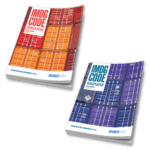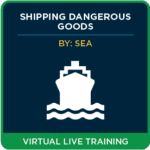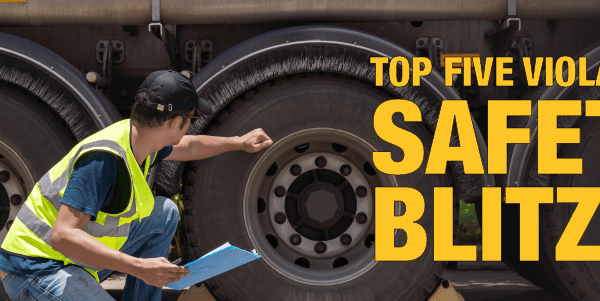This post was originally published in August 2021 and has been updated in October 2024 for accuracy.

One of the most common issues we get asked about at ICC The Compliance Center is segregation of dangerous goods. A shipper may have two different chemicals – can they ship them in the same packaging? Or even in the same freight container? The answer is important because having to separate parts of a shipment can increase the cost of transport by a lot.
Unfortunately, the solution isn’t always easy to find. Different regulations will have different requirements. For example, Canada’s Transportation of Dangerous Goods Regulations (TDG) doesn’t have any specific guidelines other than a table in section 5.7 that only applies to class 1 Explosives. On the other hand, the Hazardous Materials Regulations (HMR) in the U.S. system have a detailed table indicating classes that have to be shipped on separate vehicles, those which may be shipped without restriction, and those which may be shipped on the same vehicle but must be separated to prevent commingling in case of an accident. But the most complex system for segregation is that for marine shipments under the International Maritime Dangerous Goods (IMDG) Code. Not following these rules can result in your shipment being stopped at the port if you’ve mistakenly combined two substances that the Code has classified as requiring segregation.
Basics of IMDG Segregation
First, why is segregation so important for marine shipment. Well, if you’ve ever seen a ship at sea in a storm, you’ll understand how chemicals could mix if they both leak at the wrong time. And marine carriers transport millions of tonnes of dangerous goods per year. So, it’s important to keep chemicals from mixing during the trip.
This has led the International Maritime Organization (IMO), which created the IMDG Code, to develop a system that relies on three steps of protection:
- A generic segregation-by-class table found in section 7.2.4, IMDG Code Volume 1
- Substance-specific guidelines based on codes found in the List of Dangerous Goods, IMDG Code Volume 2
- Shipper and carrier knowledge of the substances involved
The most important thing to remember when planning a marine load is section 7.3.4.1, which states that:
“Dangerous goods which have to be segregated from each other according to the provisions in chapter 7.2. shall not be transported in the same cargo transport unit…”
In other words, if you determine that there are any applicable segregation requirements, you can’t put the two dangerous goods in the same cargo transport unit together, nor may you put them in the same package or overpack.
So, let’s take a look at how this works.
Step 1 – Consult the Segregation Table
The rules for segregation by class can be found in IMDG Code Part 7. There are a number of complexities for the crew of the vessel as to where on the ship dangerous goods of differing classes may be loaded – on deck, next to each other in compartments inside the hull, or in separate compartments. However, let’s concentrate on what the shipper needs to know. Can the classes of dangerous goods go in the same Cargo Transport Unit (CTU) or will they have to be placed in separate CTUs so they can be stowed in different areas? (Note that of course if goods can’t be placed in the same CTU, you obviously cannot package them together.)
The table for segregation by class can be found in section 7.2.4, as follows;

To determine the segregation for two classes, you would read a row for one class (across) and for the other class read a column (down). Where they intersect, you will either find the letter “X” or a number. The numbers (1, 2, 3 or 4) will tell the people stowing the goods how far apart they must be separated, as follows:
“1” – “away from” (normally, CTUs at least 3 metres apart)
“2” – “separated from” (normally, CTUs at least 6 metres apart)
“3” – “separated by a complete compartment or hold from”
“4” – “separated longitudinally by an intervening complete compartment or hold from”
Note that “1” indicates the smallest required separation, and “4” the greatest. But for the shipper this doesn’t really matter – any number indicates those classes cannot be put in the same CTU.
(Technically, section 7.3.4.1 allows you to ship goods that must be stowed “away from” each other, indicated by a “1” on the table, in the same CTU if you can obtain a permit from the “competent authority,” such as Transport Canada or the U.S. Department of Transportation. However, applying for a permit or equivalency certificate can be a time-consuming procedure, and a shipper is not guaranteed success if they apply.)
Let’s look at a couple of examples. First, let’s see if you could ship a flammable gas such as UN1978, PROPANE, in class 2.1 in the same CTU as UN1203, GASOLINE, a flammable liquid.
We find the compatibility in this case by reading across for class 2.1 and down for class 3:

Unfortunately for our planning, there is a number (“2”) where the row and column intersect. This means that we cannot put these two products into the same CTU for an IMDG shipment.
On the other hand, let’s consider a shipment of a hand sanitizer based on UN1170, ETHANOL (class 3) with UN2555, NITROCELLULOSE WITH WATER (class 4.1). We’ll look at class 3 as a row going across, and class 4.1 as a column going down:

In this case, there’s an “X” where the row and column intersect. This means that there is no automatic segregation between class 3 and class 4.1 materials.
But before we start loading our nitrocellulose and ethanol into the same freight container, we have another step to take. Next, we must check these specific substances to see if there is any other compatibility issue between them beyond the generic class compatibility.
Step 2 – Consult Segregation Requirements in the Dangerous Goods List
Just because two classes in general don’t require segregation doesn’t mean that two specific substances in those classes are in the clear. Our next step is to go to the Dangerous Goods List in Volume 2 of the IMDG Code, and check column 16b, headed “Segregation.”
In this column, we can find two sorts of codes – “SG” codes (Segregation) and “SGG” codes (Segregation Group). These will give more guidance regarding segregating specific substances and articles.
So, let’s first look up UN1170, ETHANOL:

Here, column 16b is blank. That means UN1170 doesn’t have any specific extra segregation requirements.
But it’s a little different when we look up UN2555, NITROCELLULOSE WITH WATER:

Here we have two codes in column 16b – SG7 and SG30. To find out what these codes mean, we must go to IMDG Code section 7.2.8, where they explain what these “segregation codes” represent.

The first code, SG7, means that this product needs to be segregated “away from” class 3 materials. In other words, it’s as if there were a “1” between these specific substances on the generic segregation by class table. These substances cannot be placed in the same CTU, even though the generic table indicates there is no specific segregation by class since the segregation code demands these two specific products be segregated.
The second code doesn’t affect this specific shipment, but it brings up another complication. Along with the SG codes, there may be “SGG” codes. These are “Segregation Group” codes, which apply to certain families of chemicals, regardless of their class. These chemical families will have special additional segregation requirements. The table can be found in section 7.2.5.2 and covers 18 common chemical families that can cause dangerous reactions:

According to our entry for UN2555, the chemical must be segregated from anything placed in the segregation group SGG7, “heavy metals and their salts.” This would include compounds of metals with heavy atomic weights, such as mercury (Hg), cadmium (Cd), arsenic (As), chromium (Cr), thallium (Tl), and lead (Pb).
It’s the shipper’s responsibility to assign substances to SGG codes (segregation groups) as appropriate. This is described in IMDG Code section 3.1.4. A number of common chemicals are assigned to their corresponding groups in section 3.1.4.4, but if a chemical is not listed, the shipper must make their own decision. So, for example, if you had a generic shipping name “TOXIC LIQUID, INORGANIC, N.O.S.” that contained cyanide compounds, you would assign it to SGG6, Cyanides.
If the shipping name isn’t listed in section 3.1.4.4, but the shipper believes the substance belongs in one of these groups, they must indicate the group code on the shipping document to allow the vessel crew to stow the substance safely. For example, the entry here might read “UN 3287, TOXIC LIQUID, INORGANIC, N.O.S. (potassium cyanide, sodium cyanide), 6.1, PG II, IMDG Code segregation group 6”.
Step 3 – Shipper and Carrier Knowledge
Let’s imagine we have two products – say UN1203, GASOLINE, class 3 and UN1944, MATCHES, SAFETY, class 4.1. According to the table in section 7.2.4, these two classes do not require automatic segregation – that is, there is an “X” where the two classes intersect on the table. And when we check column 16b, there are no SG or SGG codes at all for both products. Does that mean we’re clear to load them together?
Well, not quite. If you or the vessel operator believe that, despite this, there is a risk to the safety of cargo or the vessel itself from shipping the two substances in the same CTU, they should be segregated based on your understanding of the hazards. The hazards to consider are listed in section 7.2.6.1, and include:
- Combustion and/or evolution of considerable heat;
- Evolution of flammable, toxic or asphyxiant gases
- The formation of corrosive substances; or
- The formation of unstable substances.
So, if you have enough matches that you fear they might catch fire leading to the ignition of gasoline vapours in the CTU, the two products should be shipped in different CTUs.
Exceptions from Segregation
Sometimes you may be fortunate enough to have substances that appear to be incompatible but actually can be shipped together. Section 7.2.6.3 gives three situations where segregation does not need to be applied:
- Between dangerous goods of different classes which comprise the same substance but vary only in their water content. The IMDG Code gives an example of solutions of the chemical sodium sulphide, which might be classed in class 4.2 or class 8 depending on its concentration in water. Even though class 4.2 and class 8 have a “1” between them on the table in section 7.2.4, they don’t need to be segregated, since if they mix they wouldn’t react dangerously.
- Between dangerous goods which belong to a group of substances of different classes but for which scientific evidence exists that they do not react dangerously when in contact with each other. As a guide, there are three tables, 7.2.6.3.1, 7.2.6.3.2 and 7.2.6.3.3. Products on the same table don’t have to be segregated even if table 7.2.4 says they should be segregated by class. For example, UN1295, TRICHLOROSILANE, class 4.3 (3, 8) and SILICON TETRACHLORIDE, class 8, are both on table 7.2.6.3.2 and do not have to be segregated, even though class 4.3 and class 8 are listed as incompatible in section 7.2.4. Note that these tables are just common examples – if you have valid scientific evidence that your two substances can mix without a dangerous reaction, they will not be subject to segregation.
- Finally, there is a table 7.2.6.3.4 that lists certain substances (mostly organic peroxides) that may be shipped together if you believe that they cannot cause any of the dangerous reactions such as heat or evolution of dangerous gases listed in section 7.2.6.1.
In addition, the small quantity exceptions of Limited Quantities (section 3.4.4) and Excepted Quantities (section 3.5.8) are normally not subject to the segregation requirements, although section 3.4.4.2 mentions some restrictions for limited quantities of explosives class 1 when shipped in combination with fully regulated class 1 substances or articles.
Can It Be Easier?
Perhaps by now you’re wondering why the IMDG Code doesn’t have an industry-standard simplified code, such as the IATA Dangerous Goods Regulations (DGR) produced by the International Air Transport Association to make compliance with the ICAO Technical Instructions for the Safe Transport of Dangerous Goods by Air a little simpler for shippers and operators. Turns out that there is such a guide when it comes to determining compatibility, although it’s perhaps not as well known as the IATA DGR.
The Storck Guide: Stowage & Segregation to IMDG Code is produced by the German publishing company ecomed Storck GmbH but is available in English. It concentrates on IMDG’s stowage and segregation requirements, with simplified guides that make it quick and simple for vessel carriers to determine segregation requirements and plot where CTUs should be placed on vessels. Of course, this information will also be useful for shippers planning loads for ocean transport.
The Storck Guide is available in hard copy and also as a CD. Don’t forget that it must be updated once every two years, just as the IMDG Code is, based on the UN Recommendations on the Transportation of Dangerous Goods.
Conclusion
The segregation requirements of the IMDG Code are complex, and require full access to an updated version of the Code. Also, keep in mind that other regulations may have conflicting rules about segregation. If you need assistance in determining your segregation requirements, or would like to purchase an updated copy of the IMDG Code or the Storck Guide, contact us here at ICC The Compliance Center at 888-442-9628 (U.S.) or 888-977-4834 (Canada) and get the advice you need!
Sources:
International Maritime Organization, International Maritime Dangerous Goods Code
Transport Canada, Transportation of Dangerous Goods Regulations
Transport Canada, How to Apply for an Equivalency Certificate (Permit of Equivalent Level of Safety)
US Department of Transportation, Hazardous Materials Regulations, 49 CFR
PHMSA (Pipelines and Hazardous Materials Safety Administration), Hazardous Materials Approvals and Permits Overview
Ships Business, Segregation and Stowage Requirements for Dangerous Cargo – IMDG Code Guideline
MSDS Online, Lessons Learned: Improving HazCom and Avoiding the Dangers of Incompatible Chemicals
Stay up to date and sign up for our newsletter!
We have all the products, services and training you need to ensure your staff is properly trained and informed.
 IMDG Publications |
 Shipping Dangerous Goods by Sea (IMDG Code) Training Courses |






 ICC USA
ICC USA ICC Canada
ICC Canada